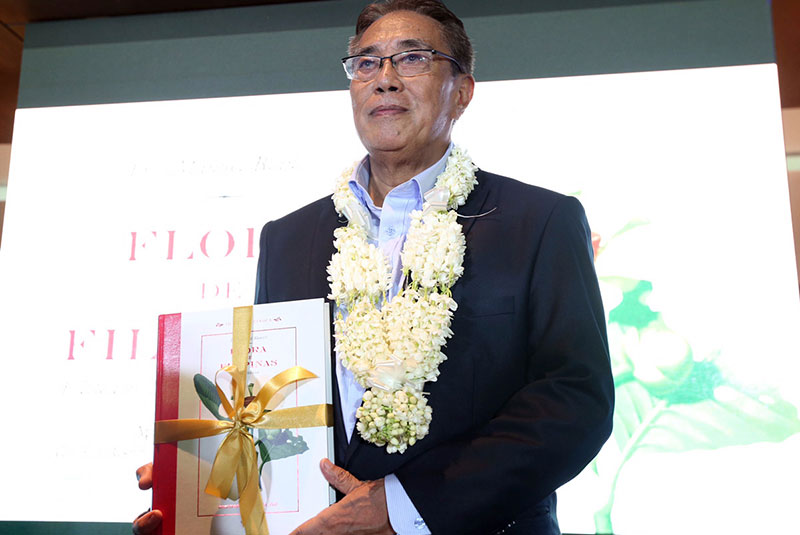Across the botanical universe: The classic ‘Flora de Filipinas’ enters the contemporary age


The first-ever handbook on Philippine plants and their practical uses gets republished 180 years after its original release. Vibal group’s philanthropic arm Vibal Foundation and Instituto Cervantes de Manila with book editor Domingo Madulid are relaunching Fr. Manuel Blanco’s iconic Flora de Filipinas. Photo by BOY SANTOS
Every new edition of this immortal tome renews the book for a new generation of readers,” says Gaspar Vibal, founder of Vibal Foundation and publisher of the fifth edition of the classic Flora de Filipinas.
A landmark work in the fields of science, art, and history, what is aptly dubbed as the immortal tome Flora de Filipinas gains new relevance in its newest and more contemporary guise. Re-launched by Instituto Cervantes de Manila and Vibal Foundation, timeless lithographs of Philippine plants done by both Spanish and Filipino artists are for the first time placed side by side with the inimitable work of Augustinian Friar Manuel Blanco, his obsolete text revived through an English translation, and now complemented with new scientific information. The book was launched along with a documentary last April 22 — 180 years after its original release, and on the eve of what Vibal notes as “the 401st death anniversary of two literary giants: Shakespeare and Cervantes.”
“To me, the book is of value being a work of a priest who was interested in the local flora,” says botanist and editor Dr. Domingo Madulid, “which to him, has many virtues and which should be made known to the public.”
In the 19th century, Fr. Manuel Blanco was sent to the Philippines after his priestly ordination. He served as a parishioner who, seeking to alleviate the ailments afflicting Filipino natives, pioneered the study and classification of 1,200 plants across the country. With no formal education in botany, Blanco nonetheless succeeded in immortalizing the variety of Philippine flora.
“The conceptual framework (of the book),” adds Vibal, “has revealed the communal nature of Fr. Blanco’s botanical research, which was done in active collaboration with Filipino curanderos, mediquillos or herbal healers.”
The work first saw print in 1837, printed in Manila at the imprenta de Sto. Tomas, and its second edition came in 1845, shortly after Blanco’s death. The third saw the book’s grandest incarnation, complete with six tomes containing the friar’s original notes, and the unpublished manuscript of the therapeutic value of local plants, authored by the first Filipino Augustinian botanist Fr. Ignacio Mercado. With these came its contribution to Philippine art history: botanical illustrations in colored lithographs, created by 17 artists, 12 of whom were Filipinos.
“Unlike some art books which feature the works of individual artists, (Flora de Filipinas) brings together the masterpiece illustrations of several artists,” says Madulid. Among those were Felix Pardo de Tavera, Lorenzo Guerrero, and Felix Resurreccion Hidalgo — yet, ironically, none of whom were highlighted in main text of the grand edition.
While the fourth edition was credited for giving the book an English translation, the latest version is more accessible to modern readers. In its current guise, Flora de Filipinas provides an introduction discussing the artists who labored over the lithographs, addressing the main shortcoming of the grand edition. It depicts only 150 plants selected from the roughly 450 original plates. “I chose the plants that were common and familiar to the readers,” says Madulid. “I selected (those) that have many local uses, like being medicinal and edible, (or those) used in local industries.”
The latest edition, born out of more than three years of intensive research, incorporates facts gleaned from 20th century botanical texts. Coupled with the plants’ original scientific names and current accepted botanical names are Madulid’s notes on their current habitats and distribution — “there are species that are abundant during Blanco’s time, but are now rare” — as well as abbreviated descriptions in more accessible terms, medicinal notes, and anecdotes relating to legends and local folklore.
Flora de Filipinas may prove to be a potent resource for local scientific circles, but ultimately its heritage has made it a covetable title for collectors across the ages. A work of the different eras’ botanists, publishers, and artists, its roots run deep in Philippine history — a record of how nature and culture combine to form a lasting relic.



















